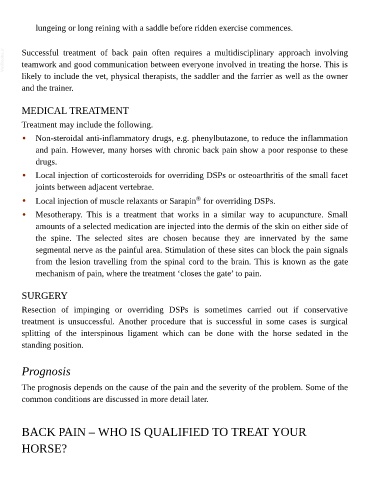Page 545 - The Veterinary Care of the Horse
P. 545
lungeing or long reining with a saddle before ridden exercise commences.
VetBooks.ir Successful treatment of back pain often requires a multidisciplinary approach involving
teamwork and good communication between everyone involved in treating the horse. This is
likely to include the vet, physical therapists, the saddler and the farrier as well as the owner
and the trainer.
MEDICAL TREATMENT
Treatment may include the following.
• Non-steroidal anti-inflammatory drugs, e.g. phenylbutazone, to reduce the inflammation
and pain. However, many horses with chronic back pain show a poor response to these
drugs.
• Local injection of corticosteroids for overriding DSPs or osteoarthritis of the small facet
joints between adjacent vertebrae.
®
• Local injection of muscle relaxants or Sarapin for overriding DSPs.
• Mesotherapy. This is a treatment that works in a similar way to acupuncture. Small
amounts of a selected medication are injected into the dermis of the skin on either side of
the spine. The selected sites are chosen because they are innervated by the same
segmental nerve as the painful area. Stimulation of these sites can block the pain signals
from the lesion travelling from the spinal cord to the brain. This is known as the gate
mechanism of pain, where the treatment ‘closes the gate’ to pain.
SURGERY
Resection of impinging or overriding DSPs is sometimes carried out if conservative
treatment is unsuccessful. Another procedure that is successful in some cases is surgical
splitting of the interspinous ligament which can be done with the horse sedated in the
standing position.
Prognosis
The prognosis depends on the cause of the pain and the severity of the problem. Some of the
common conditions are discussed in more detail later.
BACK PAIN – WHO IS QUALIFIED TO TREAT YOUR
HORSE?

